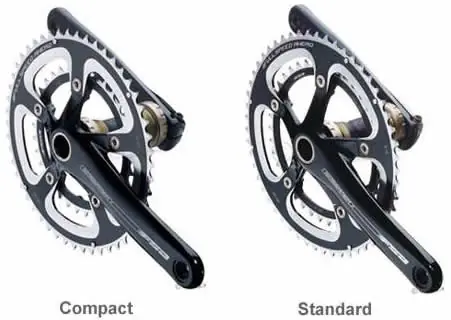What are the advantages of running compact gearing versus a standard 53 by 39 crankset? My first "real" road bike is a Schwinn Peloton, with SRAM Rival standard cranks and an 11 by 25 cogset. Most people I ride with use compact cranks. Am I at an advantage or a disadvantage?
-Max R. — Atlanta, Georgia
If you climb a lot and have less-than-spectacular fitness, you might be better served with compact gearing. If you time-trial, or spend a lot of time on club rides where you will be in a group and drafting, your taller-geared, standard drivetrain is a better choice.
More: 3 Steps to a Faster Bike Split
Generally, compact drivetrains were adopted to offer less-than-professional-level cyclists a lower gear selection in order to make it easier to climb hills without changing the top speed. Originally, compact gearing used 50 by 34 chainrings, with an 11 by 23-tooth cassette.
Compare that with conventional gearing (53 by 39 chainrings and a 12 by 25-tooth cassette) and you may be surprised that, if two cyclists are spinning at 80 revolutions per minute (rpm), the compact rider whizzes by at 28.4 miles per hour (45.8 kilometers per hour) while the standard-geared guy falls behind at 27.8 miles per hour (44.5 kph). Who would have thunk it?

While visually similar, compact cranks can give you a climbing advantage over a standard 53/39 setup
The compact geared rider gets a second advantage, too. When climbing in the 23-tooth cog, he or she climbs at 9.2 miles an hour—a slightly slower, easier pace—while the standard-gearing rider can't go any slower than 9.8 miles an hour (15.7 kph) to maintain 80 rpm with a larger, 25-tooth cog. Put the 11 by 25-tooth cassette on the compact drive bike and its rider climbs even easier; at a leisurely 8.5 miles an hour (13.7 kph) at the same 80 rpm.
More: Intro to Bike Gears
But, because your Schwinn has a 53-tooth chainring and a SRAM cassette with an 11-tooth small cog, if you have the gas to spin 80 rpm in the big ring, you can motor past the 27.6-miles-per-hour (44.5 kph), 12-tooth tough guys at a blistering 30.1 miles per hour (48.5 kph).
Now, forget all that numerical nonsense, because the truth is; it really doesn't make a difference what your gearing is until you reach the extreme high or low gear. Most enthusiasts ride near 20 miles an hour, which puts them in the big chainring and somewhere the middle of the cassette.
Few solo riders can stay on top of a compact 50 by 11 gear on level ground, and only the world's most fit can spin a 53 by 11 for any length of time, so the choice between compact and standard gearing comes down to how much you want to suffer on the climbs. For most of us, this means that compact gearing is best.
Factoid: Compact gearing was originally a trick that mountain bike component makers used to reduce the size of the chainrings and spider of a cheap, heavy crankset in order to reduce its weight.
Tip: If you want a Ph.D. course in bicycle gearing, visit Sheldon Brown's website.
More: 8 Ways to Lose Weight From Cycling
 Ready to ride? Search for a cycling event
Ready to ride? Search for a cycling event


